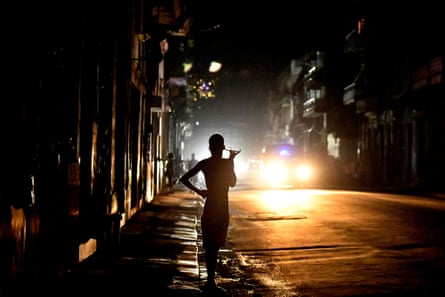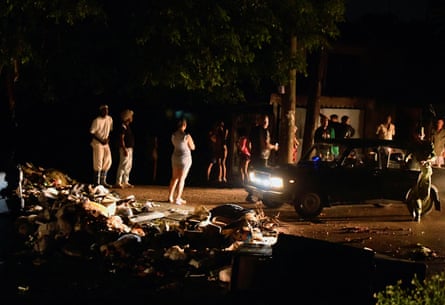Four power cuts in a weekend born of the state’s penury have caused nationwide struggles and shortages
Ruaridh Nicoll in HavanaSun 20 Oct 2024 23.23 EDTFirst published on Sun 20 Oct 2024 15.30 EDTShareDusk has become a particularly frenetic time in Havana, as Cuba prepared for a third night without electricity after repeated failed attempts to restart the national grid.
Long queues formed for bread in the capital earlier in the day. The previous night, people had emerged from humid homes to search for food, drink, news. “What’s the point of staying at home?” asked Alejandro Hernandez outside a bar in the neighbourhood of Vedado.
Throughout Sunday, much of the island started to receive electricity again, but in the late afternoon there was another collapse in power, as had been the case each night over the weekend.
Jokes, a staple of Cubans’ increasingly difficult lives, are growing more acid. “Turn the Morro back on,” people say of Havana’s lighthouse. “We haven’t all left yet.” The island has lost over 10% of its population in the last two years to emigration, well more than 1 million people.
It has become dangerous to walk the streets at night but not because of violence, rather the crumbling pavements and open drains.
 View image in fullscreenNight in Havana. Photograph: Norlys Perez/ReutersThe problem is that the Cuban government has run out of money. This has made power cuts of up to 20 hours a day a regular experience across the island, as the state struggles to buy enough fuel on the global markets for its five main thermoelectric power plants.
View image in fullscreenNight in Havana. Photograph: Norlys Perez/ReutersThe problem is that the Cuban government has run out of money. This has made power cuts of up to 20 hours a day a regular experience across the island, as the state struggles to buy enough fuel on the global markets for its five main thermoelectric power plants.
The lack of money has led to water shortages as pumps and pipes fail, rubbish piling up on street corners as collections are cut, and hunger as food prices soar.
Cuba blames its six-decade long embargo by the US for its penurious state, what Miguel Díaz-Canel, Cuba’s president, calls “ the cruellest blockade”. On Sunday night he said: “We have not had stable fuel supplies so that the system can operate at its full capacity and with all its stability.” Others, such as the respected economist Pedro Monreal, contest this, asserting that one of the world’s last centrally planned communist states has moved from sclerotic to moribund. “It is a bankruptcy caused by internal decisions,” he wrote online.
But it was a call made by the government on Thursday for all nonessential workers in its vast bureaucracy to go home and save energy that heralded this latest crisis, one unprecedented except in times when the island receives direct hit from hurricanes.
The move did not save the electrical grid, which collapsed just after 11am on Friday. The main generating station, in Matanzas, went offline. Only those who had personal generators had light.
 View image in fullscreenA woman and her parrot sit outside their house to escape the heat inside. Photograph: Norlys Perez/ReutersSince then repeated attempts by Cuba’s Union Electrica to get the grid up and running have failed. Light would appear in certain neighbourhoods, often around hospitals. But then, on Saturday at 6am and again at 10pm, the electricity went out across swathes of the country with an unnerving thump.
View image in fullscreenA woman and her parrot sit outside their house to escape the heat inside. Photograph: Norlys Perez/ReutersSince then repeated attempts by Cuba’s Union Electrica to get the grid up and running have failed. Light would appear in certain neighbourhoods, often around hospitals. But then, on Saturday at 6am and again at 10pm, the electricity went out across swathes of the country with an unnerving thump.
At 4.30pm on Sunday, the system collapsed again.
As engineers try to restore the system, the hardest-hit area has been Cuba’s west, including Havana. This has come as a shock to residents as the city has traditionally been saved from the worst, the government fearing protests. In July 2021, Cuba suffered its worst protests in memory as a demonstration against power cuts in a town west of Havana spread.
In a Caribbean country struggling to feed itself, power cuts can be particularly terrible. Without fans, night-time temperatures can keep people from sleeping, and a lack of electricity means food goes off in refrigerators. People are phoning family and friends to ask them if they have anywhere to store the small rations of meat the state gives to the most vulnerable.
During this latest crisis, the government has tried to keep the population informed. Leading figures in the government announced the initial collapse of the electricity system on X. That led to worldwide headlines, confounding an already ailing tourism industry, one of the state’s main sources of foreign funds.
A photograph was released on a government media channel showing Díaz Canel and his team standing behind two technicians in the office of the National Electricity Office. To one side was Ramiro Valdés, a former vice-president, now 92.
 View image in fullscreenPeople construct a makeshift roadblock out of rubbish to protest blackouts in Havana. Photograph: Norlys Perez/ReutersAll five of the country’s main plants are close to half a century old. According to Jorge Piñon, an expert on Cuba’s power system at the university of Texas, they are far beyond their planned lifespans.
View image in fullscreenPeople construct a makeshift roadblock out of rubbish to protest blackouts in Havana. Photograph: Norlys Perez/ReutersAll five of the country’s main plants are close to half a century old. According to Jorge Piñon, an expert on Cuba’s power system at the university of Texas, they are far beyond their planned lifespans.
Manuel Marrero, Cuba’s prime minister, has called for a shift to renewables and for the country’s growing private sector to pay more for the power it uses.
Despite the government’s messages that its technicians are working “incessantly”, comments under articles in CubaDebate, a state media outlet, show people’s anger. “This shouldn’t happen,” wrote a resident of Plaza, the neighbourhood of Havana named after the Plaza de la Revolucion. “Millions of people without electricity or water. What are all the explanations worth?”
On Saturday night, long after dusk, the streets of the Havana neighbourhood of Vedado were all but empty. The few people out were rushing home, only two members of an army patrol sauntering slowly.
